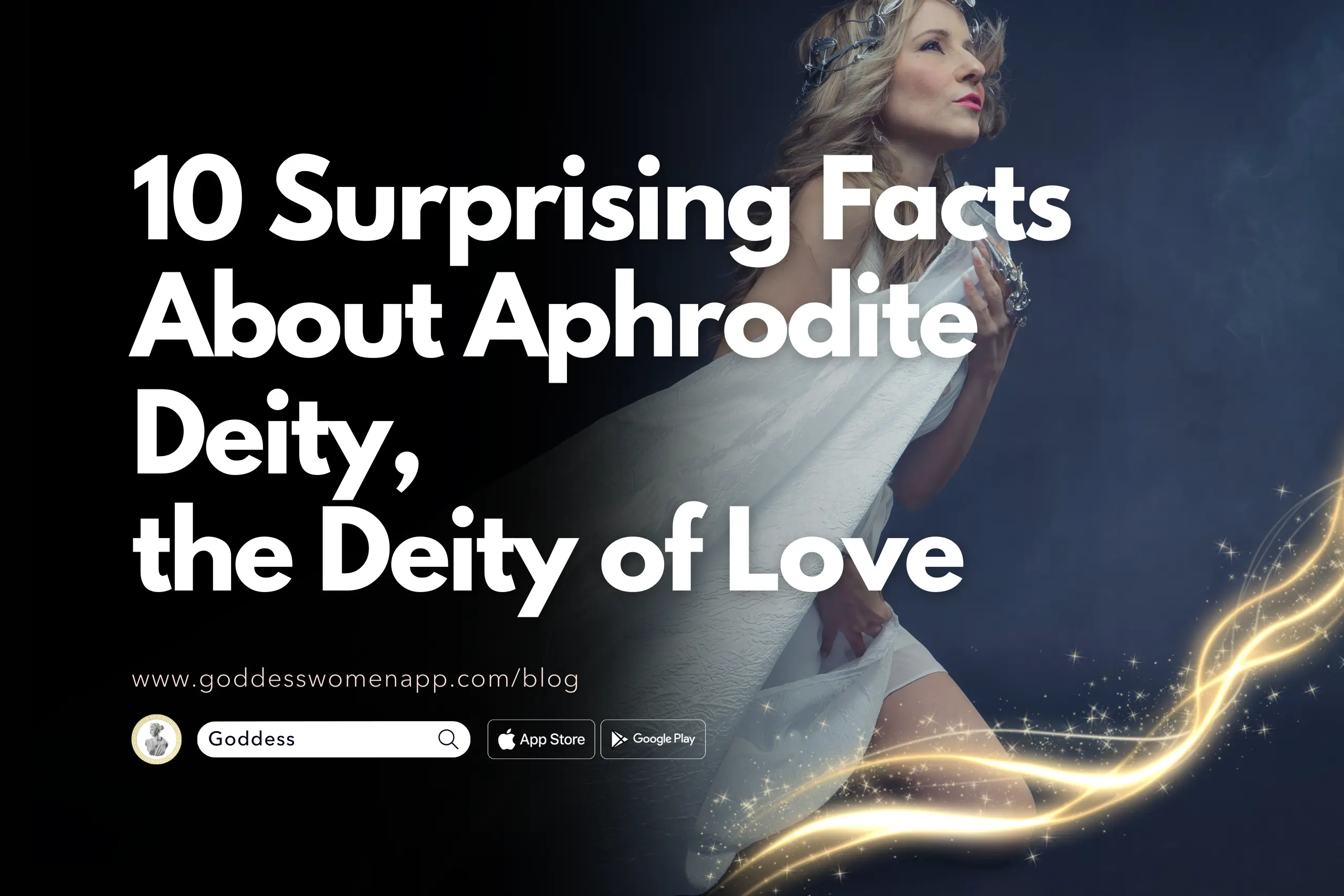1. Introduction
Aphrodite Deity, known as the deity of love and beauty, is a prominent figure in Greek mythology. Revered as the Greek goddess of love, she represents beauty and desire in Greek culture. The ancient Greek goddess Aphrodite has captivated imaginations for millennia, influencing art, literature, and religion. Greek gods, including Zeus and Ares, were frequently intertwined with Aphrodite’s stories, which ranged from the Trojan War to her romantic escapades with mortal lovers. This article delves into 10 surprising facts about this stately goddess and her influence on ancient and modern cultures.

2. Fact 1: The Origins of Aphrodite Deity
In classical mythology, there are two prevailing stories of Aphrodite’s birth. Hesiod’s “Theogony” describes how Aphrodite arose from sea foam after Cronus severed his father Uranus’s genitals and cast them into the loud-moaning sea. The foam created from this act floated across the water to the shores of Cyprus, where the Greek goddess of love emerged. The golden filleted Hours welcomed her, and she was adorned with golden necklaces and heavenly garments.
Homer, in the “Iliad,” depicts a different origin, naming Aphrodite as the daughter of Zeus and the goddess Dione. In both versions, Aphrodite is closely linked to love and beauty.
In early Greek art, Aphrodite was portrayed as a fully clothed woman, reflecting the cultural norms of the time. However, over time, the goddess of love and beauty was increasingly represented in art with more emphasis on her beauty and less on modesty. The Roman poet Ovid popularized this image further, giving Aphrodite, known to the Romans as Venus, her title of Venus Genetrix.
One of the most famous stories associated with Aphrodite is her involvement in the Trojan War. This tale begins with the golden apple inscribed “For the most beautiful,” which was thrown by Eris, the goddess of discord, at a banquet. The golden apple was claimed by three goddesses: Aphrodite, Hera, and Athena. They asked the Trojan hero Paris to judge the contest, and he awarded the apple to Aphrodite, who promised him the most beautiful woman in the world, Helen of Troy. This led to the Trojan War, a defining moment in ancient Greek history.
Aphrodite continued to play a significant role in mythology and art. She was depicted in Greek art through votive offerings, paintings, and sculptures, such as the famous Roman marble copy, the Venus de Milo. As the goddess of love, she was known for her many mortal lovers, such as Adonis, who was killed by a wild boar, and Anchises, with whom she had her son Aeneas. Aphrodite’s worship spread from southern Italy to other parts of the Mediterranean, solidifying her status as a victorious goddess who held sway over love and desire.

3. Fact 2: Aphrodite’s Role in Greek Mythology
Aphrodite, the goddess of love and beauty, holds a prominent position in Greek mythology. Her influence spans numerous tales, from the Trojan War to enchanting all the gods with her charm. Known as the Greek goddess of love, she was often at the heart of stories involving love, lust, and desire.
Aphrodite played a significant role in the Trojan War. The famous story involves a golden apple inscribed with “For the most beautiful” that was presented to her, Hera, and Athena by the sun god. In a contest to see who was the most beautiful woman, the Trojan hero Paris chose Aphrodite after she promised him Helen, the most beautiful woman on Earth. This choice set in motion the chain of events that led to the Trojan War, involving walled cities and epic battles. Aphrodite continued to influence the war, helping her favored heroes, like her son Aeneas, who was fathered by the mortal Anchises.
As a deity of beauty, Aphrodite was often depicted in Greek art and votive offerings. In early Greek art, she was portrayed modestly but was later depicted more openly with beauty emphasized. Roman poets adapted her character into Roman mythology, where she was known as Venus. Her classical image became iconic, influencing artists and sculptors, leading to famous works like the Roman marble copy, the Venus de Milo.

4. Fact 3: The Greek Goddess and Her Symbolism
The ancient Greek goddess Aphrodite is known for her association with love, beauty, and desire. Aphrodite’s birth, arising from sea foam according to Hesiod’s “Theogony,” made her a symbol of beauty born from the ocean’s soft foam. She was often depicted adorned in heavenly garments and golden necklaces, capturing the imagination of all the gods and mortals alike.
Aphrodite’s symbolism includes sacred birds, precious gold, and lovely dances. Her symbols, like doves and swans, represent love and desire. She was often accompanied by her son Eros, the god of love, and depicted with other symbols like seashells and pearls. The “gold filleted Hours welcomed” Aphrodite as she emerged from the sea, crowning her the victorious goddess of beauty.
In votive offerings and Greek art, Aphrodite was depicted as the most beautiful woman. She often appeared in scenes with other gods and goddesses, reflecting her beauty and allure. Her statues and paintings emphasized her soft neck, snow-white breasts, and moist breath, symbolizing fertility and life. Aphrodite’s children, including her son Aeneas, played crucial roles in myths, with her influence reaching far and wide.

5. Fact 4: Ancient Greek Goddess of Love and Desire
Aphrodite, the ancient Greek goddess of love and desire, is a legendary figure in Greek mythology. As the deity of love and beauty, she embodies passion and attraction, captivating all the gods and mortals alike. Born from sea foam according to Hesiod’s “Theogony,” Aphrodite’s birth marked the emergence of one of the most alluring figures in Greek mythology.
In classical mythology, Aphrodite’s influence was pervasive. Her beauty and charms swayed gods, mortals, and even nature itself. Early Greek art depicted her as a modest, stately goddess, but later artworks showed her more openly, emphasizing her snow-white breasts and golden necklaces. She was widely worshiped, with votive offerings made to honor her across Greece and southern Italy.
Aphrodite’s worship also spread to Roman mythology, where she was known as Venus. The Roman poet Ovid highlighted her role as Venus Genetrix, linking her to fertility and motherhood. Her statues and depictions, like the famous Roman marble copy of the Venus de Milo, celebrated her as the epitome of beauty and desire. Her sacred birds, such as doves and swans, and other symbols, such as pearls and roses, have long represented love and desire in art and literature.

6. Fact 5: Greek Gods and Aphrodite’s Relationships
Aphrodite’s relationships with Greek gods and mortals were central to her myths. Although she was married to Hephaestus, the god of the forge, she had many lovers, including other Greek gods like Ares, the god of war. Their passionate affair led to one of the most famous stories in Greek mythology, when Hephaestus caught them together in a golden net.
Among her mortal lovers was Adonis, the beautiful youth who was killed by a wild boar, causing great sorrow for Aphrodite. She also fell in love with Anchises, with whom she had her son Aeneas, who would later become a Trojan hero in the Trojan War. Aeneas carried on her legacy, as his descendants were said to have founded Rome, further linking Aphrodite to Roman mythology.
Aphrodite was known to wear a magical girdle, which made her irresistible to all the gods and mortals. She wielded great influence, often using her charms to sway decisions, as in the case of the golden apple inscribed “For the most beautiful.” The golden filleted Hours welcomed her into Olympus, where she held a significant position among the gods, admired for her beauty and power.

7. Fact 6: The Power of Aphrodite Deity
The power of Aphrodite, the Greek goddess of love and beauty, was undeniable. She wielded influence over the hearts and minds of gods and mortals alike. Her power was evident from the day of her birth, when she arose from the sea foam, creating a sense of awe among the Greek gods. Her beauty enchanted the other gods, and her ability to ignite love and desire became a defining trait.
In classical mythology, Aphrodite’s power was often demonstrated through her magical girdle, which could make anyone who wore it irresistible. The goddess of love could sway the decisions of mortals and gods alike, affecting their fates. The golden apple inscribed “For the most beautiful,” awarded to Aphrodite by Paris, exemplifies her power over love and desire. This act set the Trojan War in motion, showcasing her influence over the most famous story in Greek mythology.
Aphrodite was also known for her power over nature. Her sacred bird, the dove, became a symbol of peace and love, often associated with her. Her son Eros, also known as the god of love, further amplified her influence. He played a vital role in Greek mythology by using his arrows to inspire love between gods and mortals. Aphrodite’s worship was widespread, with votive offerings made to her in southern Italy and across the Mediterranean. The Roman poet Ovid even celebrated her as Venus Genetrix, linking her to motherhood and fertility.
8. Fact 7: Greek Mythology’s Tales of Aphrodite
Greek mythology is filled with tales of Aphrodite, the ancient goddess of love and beauty. One of the most famous stories involving Aphrodite is her involvement in the Trojan War. After winning the golden apple contest judged by Paris, she promised him the love of Helen, the most beautiful woman in the world. This decision led to the war that would shape ancient Greek history and literature.
Another notable story is that of Adonis, one of her mortal lovers. Adonis was killed by a wild boar, which deeply grieved Aphrodite. In another tale, Aphrodite married Hephaestus, but their relationship was marred by her love affair with Ares. Her infidelity was exposed when Hephaestus captured the two in a net, revealing their affair to the other Greek gods.
Aphrodite’s children, particularly her son Aeneas, played significant roles in classical mythology. Aeneas, the Trojan hero, became a key figure in the mythological transition from Greek to Roman mythology. Aphrodite’s worship and stories of her beauty and charm were carried into Roman mythology, where she was known as Venus. Roman art often depicted her in her various roles, with one of the most famous representations being the Roman marble copy of the Venus de Milo.
In early Greek art, Aphrodite was portrayed with a modest demeanor, reflecting the values of ancient Greek culture. As the goddess of love and beauty, her influence on Greek mythology continues to captivate audiences, embodying timeless ideals of love, desire, and beauty.

9. Fact 8: The Influence of the Greek Goddess in Art
The influence of the Greek goddess Aphrodite on art is immense. As the goddess of love and beauty, her imagery has inspired artists from ancient Greek times through to the modern era. Early Greek art depicted Aphrodite, sometimes modestly clothed, emphasizing her allure with soft necks and snow-white breasts, celebrating her divine beauty.
In classical mythology, the goddess was frequently shown in votive offerings and sculptures, symbolizing love and desire. Aphrodite’s worship extended across the Mediterranean, particularly in southern Italy, where her influence flourished. One of the most famous representations is the Roman marble copy of the Venus de Milo, which embodies the goddess’s classical beauty.
Roman poets also shaped Aphrodite’s image, emphasizing her beauty and romantic escapades. Her eastern origins and mythical tales have given rise to countless representations in Greek art, including paintings, sculptures, and mosaics. Aphrodite’s sacred birds, the dove and swan, became symbols of love in Greek mythology. Her impact on art is also evident in the “Venus Genetrix” statues, which represent her as the surrogate mother of the Roman people.
10. Fact 9: The Legacy of Aphrodite Deity
The legacy of Aphrodite, the ancient Greek goddess of love, continues to influence modern culture. From ancient Greek mythology to Roman mythology, she represents the epitome of beauty, love, and desire. Aphrodite’s birth from sea foam, as described in Hesiod’s “Theogony,” marks her as a goddess who transcends time.
Aphrodite’s stories continue to resonate, from her role in the Trojan War to her son Aeneas’s journey in Roman mythology. Her image has endured in classical and contemporary art, solidifying her status as the goddess of love and beauty. Whether as the stately Aphrodite adorned in heavenly garments or the victorious goddess influencing all the gods, she has remained a symbol of desire and attraction.
The golden apple inscribed “For the most beautiful” that sparked the Trojan War is one of the most famous stories in mythology, showing the far-reaching influence of Aphrodite’s power. Even in modern literature, film, and art, the legacy of the goddess lives on, continuing to inspire generations with her tales of love and beauty. The golden crowned goddess remains a timeless symbol of the powerful forces that drive human emotions, proving that the allure of the goddess Aphrodite continues unabated.

11. Fact 10: Modern Interpretations of the Ancient Greek Goddess
In modern culture, Aphrodite remains a symbol of beauty and love, inspiring countless interpretations and adaptations of the ancient Greek goddess. Her influence stretches from ancient Greek mythology to contemporary media, where her role as the goddess of love continues to captivate audiences. Aphrodite’s worship has transcended time, evolving from the ancient Greek deity to the Roman goddess Venus and into modern figures that represent beauty and love in various forms.
The golden apple inscribed “For the most beautiful,” which set in motion the Trojan War, reflects the timeless impact of Aphrodite’s mythos. She is frequently depicted in art and literature as a beautiful woman surrounded by precious gold and sacred birds. In cinema, her influence can be seen in movies and shows that explore themes of love and desire, often portraying her as a character or an archetype.
Her status as a victorious goddess who conquered the hearts of both gods and mortals is mirrored in how her archetype appears in different cultures. From the Roman marble copy of Venus de Milo to the Homeric hymn that sings of her beauty, Aphrodite’s legacy is cemented in the foundations of Western culture.
12. Conclusion
The legacy of the ancient Greek goddess of love, Aphrodite, is felt deeply in today’s world. From early Greek art that portrayed her as a stately goddess adorned in golden necklaces to her impact on the Trojan hero Aeneas, Aphrodite’s worship has remained unwavering. As one of the most influential deities in classical mythology, she continues to shape modern interpretations of love and beauty.
Aphrodite’s tales have influenced Greek mythology and beyond, offering lessons in passion, beauty, and desire that resonate with audiences today. Her influence on classical and Roman mythology has shaped her into a cultural icon, inspiring art, literature, and modern interpretations of beauty.
Understanding the allure of Aphrodite can help us recognize the enduring archetypes that influence our perception of beauty and love. To explore which goddess archetype you resonate with, download the Goddess app today and discover your inner Aphrodite or another goddess who represents your unique essence.





